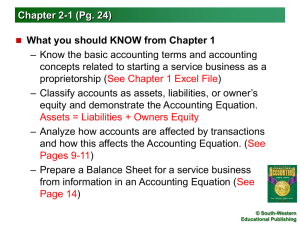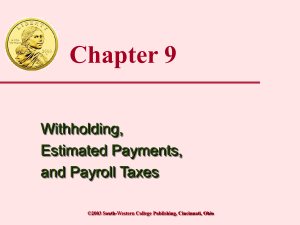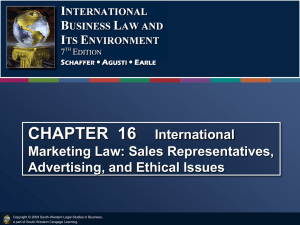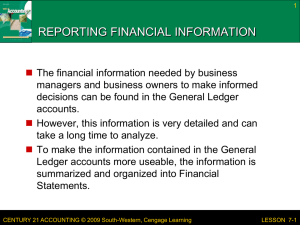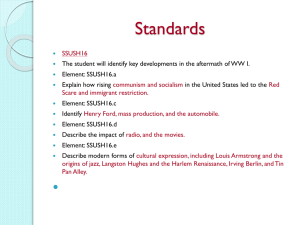CHAPTER 6 - Home Page
advertisement
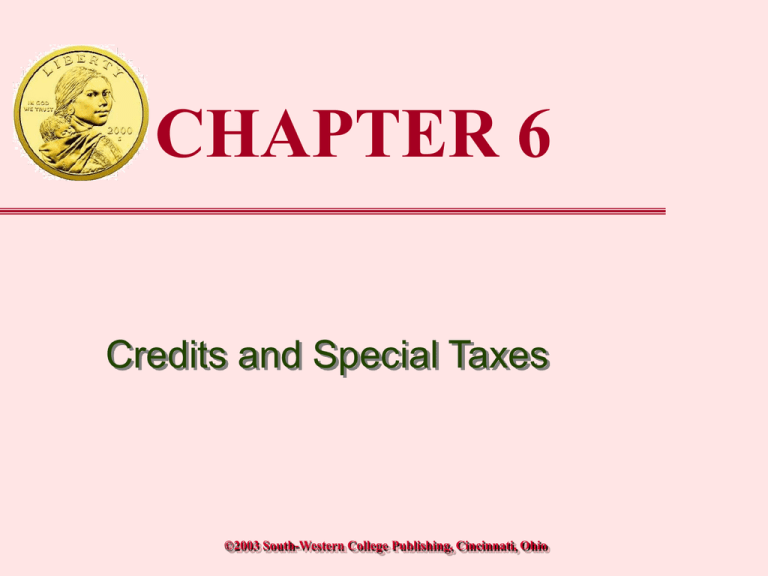
CHAPTER 6
Credits and Special Taxes
©2003 South-Western College Publishing, Cincinnati, Ohio
Objective
Know the difference between
deductions and credits
© 2003 South-Western College Publishing
Transparency 6-2
Credits and Deductions
A credit is a direct reduction in tax
liability
Credits are used to target certain groups for
tax benefit
A deduction is a reduction of taxable
income and only an indirect
reduction in tax liability
© 2003 South-Western College Publishing
Transparency 6-3
Tax Credits
Illustration of difference between a $1,500 deduction and a $1,500 credit
AGI
Deduction
Deduction
$ 70,000
Credit
$ 70,000
(1,500)
-0-
TI
$ 68,500
$ 70,000
Tax Liability
$ 13,620
$ 14,070
Credit
Tax due
-0$ 13,620
(1,500)
$ 12,570
*This is assuming a single taxpayer in the 30% tax bracket
© 2003 South-Western College Publishing
Transparency 6-4
Objective
Be able to calculate several
common tax credits
© 2003 South-Western College Publishing
Transparency 6-5
Elderly/Disabled Credit
(Schedule R)
Provides tax relief for those not adequately
covered by Social Security
Targets taxpayers > 65, or < 65 with total
disability
This credit rarely shows up - qualifying is
very difficult
© 2003 South-Western College Publishing
Transparency 6-6
Elderly/Disabled Credit Calculations
For Single, or MFJ with only one > 65
Credit base = {$5,000 - nontaxable SS benefits .50 [AGI - $7,500 (single) or $10,000 (married)]}
Credit = Base X 15%
For MFJ with both > 65
Credit base = {$7,500 - nontaxable SS benefits .50(AGI - $10,000)}
Credit = Base X 15%
© 2003 South-Western College Publishing
Transparency 6-7
Elderly Credit Example
Sue is single, 68, and has Dividend income
Schedule E income
Nontaxable SS
Wages
=
=
=
=
$ 150
$4,400
$3,200
$2,000
Calculations for single taxpayer:
Base = $5,000 - $3,200 - .50($6,550 - $7,500)
= $5,000 - $3,200 - $0
= $1,800
Credit = $1,800 X 15% = $270
This credit is reported on page 2 of Form 1040
© 2003 South-Western College Publishing
Transparency 6-8
Elderly Credit Example 2
Wayne and Tammy are both 65 years old and file a joint return.
AGI = $11,000 and they also receive nontaxable social security
payments of $3,000 during the current year.
Calculations for MFJ, two > 65:
Base = $7,500 - $3,000 - .50($11,000 - $10,000)
= $7,500 - $3,000 - $500
= $4,000
Elderly tax credit = 15% X $4,000 = $ 600
The $600 credit is allowed only to the extent that Wayne and
Tammy have actual income tax due before credits, so if their
total tax due = $400, the $600 credit is really only worth $400
netting them a $0 balance due.
© 2003 South-Western College Publishing
Transparency 6-9
Child Tax Credit
Provides tax relief through a nonrefundable
credit to taxpayers with children
Taxpayer receives credit for each child under age
17 claimed as a dependent
Credit is $600 per child
Credit phased out when AGI > $110,000 (MFJ); >
$75,000 (HH, S); or AGI > $55,000 (MFS)
Reduction = $50[(AGI - threshold)/1,000]
If have 3+ children may calculate differently
on Form 8812
© 2003 South-Western College Publishing
Transparency 6-10
Child Tax Credit Example
Taxpayers have children ages 19, 10, and 3. Their
AGI is $113,200. What is their Child Tax Credit?
•Have only two qualifying children
•AGI exceeds threshold, therefore must figure
phase-out
($113,200 - $110,000) / $1,000 = 3.2
Round to 4 X $50 = $200 reduction
•Credit = ($600 X 2) - $200 = $1,000
© 2003 South-Western College Publishing
Transparency 6-11
Earned Income Credit (Schedule EIC)
Refundable credit originally designed for working
parents (although now can also get if fairly low
income with no kids)
Qualify if
Between ages 25 and 65 with no children
Any age with one child
Married taxpayers must file MFJ
Earned income defined as:
Wages plus deferred compensation
Self Employment income
Meals/lodging provided by employer
© 2003 South-Western College Publishing
Transparency 6-12
Earned Income Credit (Continued)
Qualifying child (for EIC purposes)
Relationship test: (child, descendant of child,
stepchild, foster child, or adopted child)
Residency test: Live more than 50% of year at
taxpayer’s home
Fulltime students can live away from home
Foster children must reside all year
Age test: Under 19 (or 24 if FT student) or totally
disabled at end of tax year
© 2003 South-Western College Publishing
Transparency 6-13
To Calculate EIC
Use EIC tables to calculate or ask IRS to
figure for you on Schedule EIC
EIC is reported on page 2 of 1040
What is different about how this credit is reported
on the 1040 compared to other credits?
It is refundable and therefore more like a “payment” than
a credit
© 2003 South-Western College Publishing
Transparency 6-14
Child and Dependent Care Credit
(Form 2441)
Gives tax relief to working parents who must provide
childcare for dependents
Dependent must be under age 13 or
Spouse or dependent who cannot care for themselves
Calculation
Determine qualifying care costs: limited to the lesser of
Earned income of lowest earning spouse, or
$2,400 (for 1 dependent) or $4,800 (for 2 or more dependents)
If spouse is FT student, count him/her as earning $200/month
(1 child) or $400/month (2+ children)
Must reduce by any amount reimbursed by employer
Multiply costs by a percentage that decreases from 30%
down to 20% based on AGI (Table 1 in book)
© 2003 South-Western College Publishing
Transparency 6-15
Dependent Care Credit Examples
Joanne has salary of $18,400 and investment income of $2,100. Lou is a full-time
student. They have 3 children and total daycare costs of $5,800. What is their
Child Care Credit?
Qualifying costs are the lesser of:
Her earned income
$18,400
His earned income
$ 4,800 (imputed at $400 / month)
Daycare bill
$ 5,800
Multiply by % from Table 1:
$4,800 x 24% = $1,152 credit
What if Lou works part time, earning $3,000, and Joanne received $2,200 of
employer-provided dependent care assistance?
Qualifying costs would be lesser of:
Net daycare bill $5,800 - $2,200 = $3,600
Lou’s earnings
$3,000
Multiply by % based on new AGI:
$3,000 x .23 = $690 credit
© 2003 South-Western College Publishing
Transparency 6-16
Education Credits: Hope Credit
Provides tax relief for higher education expenses (tuition
and fees) net of scholarship or reimbursement
Available for each eligible student in first 2 years of
college
Eligible students are taxpayer, spouse or eligible dependent
Student must be 1/2 time and not had felony conviction for
possessing or distributing a controlled substance
Credit = 100% of first $1,000 + (50% of the next $1,000)
Maximum credit = $1,500
Phased out when AGI > $41,000 (S) or $82,000 (MFJ)
MFS do not qualify
© 2003 South-Western College Publishing
Transparency 6-17
Education Credits:
Lifetime Learning Credit (LLC)
Provides tax relief for higher education expenses
(tuition and fees) net of scholarship or reimbursement
Credit = 20% of first $5,000
Maximum credit = $1,000 per year
Subject to same phase outs as Hope Credit and MFS do not
qualify
LLC can be used for part time students
Not limited to first two years
Graduate school expenses qualify
No limit on number of years you may claim LLC
© 2003 South-Western College Publishing
Transparency 6-18
How do LLC, Hope Credit and
Educational IRAs Work Together?
For each student, taxpayer can get only one of the
credits or a tax-free withdrawal from an EIRA
Can claim Hope for first two years of student’s school and
then LLC in later years
If taxpayer pays for more than one student in same year,
may take Hope for one student and LLC for another
Only the person claiming the exemption can claim a
credit
If parent cannot claim child as dependent, only the child can
claim education credit (who may lose it because of
insufficient tax liability)
© 2003 South-Western College Publishing
Transparency 6-19
Education Credits -Example
Dave and Val (MFJ) claim 2 dependent children and
have AGI of $72,000. Sean is a senior at NJSU. His
tuition is $2,200. Corey is a freshman at Tulane. Her
tuition is $19,200.
Calculation
Sean only qualifies for LLC because of his senior status.
(20%)($2,200) = $440
Corey, a freshman, qualifies for the Hope Credit.
(100%)($1,000) + (50%)($1,000) = $1,500
© 2003 South-Western College Publishing
Transparency 6-20
Foreign Tax Credit (Form 1116)
Provides relief from double taxation on
money generated from foreign sources
Taxpayers pay foreign and U.S. tax on all income
and then take credit up to amount paid foreign
governments
Credit = actual amount paid, but limited to:
Net foreign income
Total U.S. taxable income
X
U.S. Tax Liability
before the credit
Thus, may not get full credit
Can carryback 2 years and forward 5 years
© 2003 South-Western College Publishing
Transparency 6-21
Foreign Tax Credit Example
Joe Steele had $200,000 income from US and
$100,000 income from employment in Kuwait. He paid
$40,000 in Kuwaiti taxes. His US tax liability on
$300,000 is $88,313.
Calculate
Maximum Foreign Tax Credit is the $40,000 paid, but
limited to:
($100,000/$300,000) x $88,313 = $29,438
Carry back or forward the difference:
($40,000 - $29,438) = $10,562
© 2003 South-Western College Publishing
Transparency 6-22
Work Credits
Welfare-To-Work Credit (for employers)
Amount:
Up to 35% of $10,000 wages for 1st year credit
Up to 50% of $10,000 wages in 2nd year credit
Employees must be designated as a long term
assistance candidate
Credit may be taken for each qualified employee
Must reduce wage expense by amount of credit
taken
© 2003 South-Western College Publishing
Transparency 6-23
Work Credits
Work Opportunity Credit (for employers)
Credit = 40% of first $6,000 of wages
Reduced to 25 % if employee performs < 400 hours of
service
Not allowed for employees who perform < 120 hours
Employees must be hired from high risk groups
(felons, welfare recipients, underemployed youth,
veterans, etc.)
Must reduce wage expense by amount of credit
taken
© 2003 South-Western College Publishing
Transparency 6-24
Disabled Access Credit
For employers
Provides relief for small businesses complying with 1990
ADA mandated structural requirements
Available only to existing businesses with $1M or less in sales and
30 or fewer employees)
Credit = (50%) x (amount spent - $250)
Maximum amount eligible is $10,250; therefore, maximum credit
is $5,000
Must reduce depreciable basis of asset by amount of credit
Example: Qualifying business builds a ramp for cost of
$16,000. Credit = ($10,250 - 250) x (50%) = $5,000
© 2003 South-Western College Publishing
Transparency 6-25
Adoption Credit (Form 8839)
Provides relief to taxpayers who pay adoption
expenses
Credit is amount spent up to $10,000 per adoption
Adoption credit phases out at AGI > $150,000
Different rules if pay expenses over more than 1 year or if
foreign adoption
If employer helps employee with adoption expenses, this
benefit is excludable from W-2 up to $10,000
Qualified adoption expenses include court costs,
legal fees, travel, etc.
May claim adoption credit and adoption exclusion for
same adoption, but cannot claim both and exclusion
for the same expense
© 2003 South-Western College Publishing
Transparency 6-26
Objective
Have a general understanding
of the Alternative Minimum Tax
Calculations
© 2003 South-Western College Publishing
Transparency 6-27
Alternative Minimum Tax
(Form 6251)
Tax was originally intended for high income
taxpayers with many shelters; it has evolved
to impact many middle income people
Separate system for calculating taxes
If Alternative Minimum Tax (AMT) is higher than
regular federal tax liability, must pay AMT amount
AMT Rates
26% up to $175,000 ($87,500 MFS) Alternative
Minimum Taxable Income (AMTI)
28% above $175,000 ($87,500 MFS) AMTI
Long-term capital gains taxed at preferential rates
© 2003 South-Western College Publishing
Transparency 6-28
Alternative Minimum Tax
Calculation of Alternative Minimum Taxable
Income (AMTI)
+/+
-
Taxable Income (from 1040)
Adjustments
Tax Preferences
AMT Exemption
AMTI
AMTI x rate = Alternative Minimum Tax
© 2003 South-Western College Publishing
Transparency 6-29
Alternative Minimum Tax Adjustments
Examples of negative adjustments (subtract from TI)
State income tax refunds
AMT NOL
Examples of positive or negative adjustments
NOL
Some passive losses
Difference in regular depreciation and AMT depreciation
Exemptions
Most itemized deductions except:
mortgage interest
contributions
investment interest
casualty losses
gambling losses
© 2003 South-Western College Publishing
Transparency 6-30
Alternative Minimum Tax (continued)
Examples of Tax Preference Items
Excess depreciation on real estate over straight line
Excess depletion over cost, intangible drilling costs
Tax exempt interest on private activity bonds
(municipal bonds issued to further a nongovernmental activity - like an industrial park)
AMT Exemption Amounts
$49,000 (MFJ); $24,500 (MFS); $35,750 (Others)
Exemption is reduced by $.25 for each dollar of AMTI
over phase-out amount
$150,000 (MFJ), $75,000 (MFS), $112,500 (Others)
© 2003 South-Western College Publishing
Transparency 6-31
AMT Example
Ralph and Lana (MFJ) report the following on their Form
1040:
Gross income:
Salary
$ 70,000
Dividends/Interest
10,000
Schedule C income
30,000
40,000
AGI
$110,000
Itemized Deductions:
Real Estate taxes
$10,000
Mortgage interest
18,000
Non cash contributions
8,000
( 36,000)
Exemptions ($3,000 X 2)
( 6,000)
Taxable Income
$ 68,000
Regular Tax
$ 11,730
© 2003 South-Western College Publishing
Transparency 6-32
AMT Example
AMT Calculation
TI from Form 1040
Add back positive adjustments:
Exemptions
Real Estate Taxes
Subtract negative adjustment (none)
Add back tax preference items (none)
AMTI
AMT Exemption
AMT tax rate
Alternative Minimum Tax
© 2003 South-Western College Publishing
$ 68,000
6,000
10,000
0
0
$ 84,000
(49,000)
$ 35,000
x 26%
$ 9,100
Transparency 6-33
Objective
Understand the rules for
computing tax on the unearned
income of minor children
© 2003 South-Western College Publishing
Transparency 6-34
Unearned Income of Minor
Children
Provision designed to prevent parents from
transferring income-producing assets to
children in lower tax brackets
Net unearned income of child under age 14 must
be taxed at the parent’s highest tax rate
NUI = Unearned income - (greater of $750 or Investment
expenses) - $750
© 2003 South-Western College Publishing
Transparency 6-35
Tax for Children under age 14 “Kiddie
Tax” (8615)
Must use Form 8615 if child is under 14, has
investment income > $1,500 and also has capital
gains or earned income
If child is under 14 and has only interest/dividends
with income between $750 and $7,500, parents may
report the income on their return using Form 8814
(rather than file return for child)
If parents file Form 8814
Take standard deduction of $750 for each child
Pay 15% on next $750
The remainder is reported on parent’s 1040 as “other income”
© 2003 South-Western College Publishing
Transparency 6-36
Parents Election to Report Child’s
Interest/Dividends - (8814)
Reporting income on child’s tax return
No personal exemption allowed
Standard deduction is the greater of earned
income or $750
as limited by “regular” standard deduction
The tax on the net unearned income (such as
dividends, interest, capital gains) of a child under
age 14 is figured by using the parent’s highest
marginal tax rate
© 2003 South-Western College Publishing
Transparency 6-37
Objective
Know the different rules for
married taxpayers residing in
community property states
© 2003 South-Western College Publishing
Transparency 6-38
Community Property and Taxation
Nine states - AZ, CA, ID, LA, NV, NM, TX, WA, WI follow the community property system
Assumes that all property is either separate or
community
Separate: acquired before marriage (or acquired through gift
or inheritance after marriage)
Community: acquired after marriage
2 approaches
Income from all property is taxed as community property
(LA, ID, TX)
Income from separate property is taxed as separate property
(other 6 states)
© 2003 South-Western College Publishing
Transparency 6-39
That’s all!
© 2003 South-Western College Publishing
Transparency 6-40
